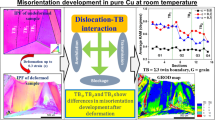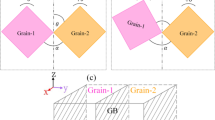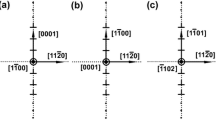Abstract
Atomistic simulations were performed to investigate the relationships among the misorientation, dislocation density, and grain boundary energy of twist and tilt bi-crystal grain boundaries. In this work, the grain boundary energies were calculated based on the embedded-atom method interatomic potential for Cu. The results show that the dislocation density of the grain boundary changes with the rotation angle, thereby affecting the grain boundary energy. Furthermore, the grain boundary energy of a grain boundary with no dislocations is greater than that of a grain boundary with dislocations, which results from the distribution of the atomic potential energy on the grain boundaries. Additionally, the grain boundary energy increases with the dislocation density of the grain boundary in the case of dislocations on the grain boundary. On this basis, a new relationship is proposed for the misorientation angle and grain boundary energy. We assume that when the driving force of dislocation nucleation breaks through the grain boundary energy barrier, the grain boundary energy declines.















Similar content being viewed by others
Data availability
The datasets generated during and/or analyzed during the current study are not publicly available due to further researches based on these datasets are still processing but are available from the corresponding author on reasonable request.
Code availability
The open-source software used in this study are LAMMPS and OVITO, which can be downloaded from the website, and the code scripts for simulation and calculation are available from the corresponding author on reasonable request.
References
Wolf D (1990) Structure-energy correlation for grain boundaries in FCC metals—III. Symmetrical tilt boundaries. Acta Metallurgica et Materialia 38(5):781–790
Wolf D (1990) Structure-energy correlation for grain boundaries in f.c.c. metals—IV. Asymmetrical twist (general) boundaries. Acta Metallurgica et Materialia 38(5):791–798
Wolf U, Ernst F, Muschik T, Finnis MW, Fischmeister HF (1992) The influence of grain boundary inclination on the structure and energy of σ = 3 grain boundaries in copper. Philos Mag A 66(6):991–1016
Rittner J, Seidman DN (1996) < 110> symmetric tilt grain-boundary structures in fcc metals with low stacking-fault energies. Phys Rev B 54(10):6999
Sangid MD, Ezaz T, Sehitoglu H, Robertson IM (2011) Energy of slip transmission and nucleation at grain boundaries. Acta Mater 59(1):283–296
Sangid MD, Sehitoglu H, Maier HJ, Niendorf T (2010) Grain boundary characterization and energetics of superalloys. Mater Sci Eng, A 527(26):7115–7125
Olmsted DL, Foiles SM, Holm EA (2009) Survey of computed grain boundary properties in face-centered cubic metals: I. Grain boundary energy. Acta Materialia 57(13):3694–3703
Holm EA, Olmsted DL, Foiles SM (2010) Comparing grain boundary energies in face-centered cubic metals: Al, Au, Cu and Ni. Scripta Materialia 63(9):905–908
Holm EA, Rohrer GS, Foiles SM, Rollett AD, Miller HM, Olmsted DL (2011) Validating computed grain boundary energies in fcc metals using the grain boundary character distribution. Acta Mater 59(13):5250–5256
Upmanyu M, Srolovitz DJ, Lobkovsky AE, Warren JA, Carter WC (2006) Simultaneous grain boundary migration and grain rotation. Acta Mater 54(7):1707–1719
Sangid MD, Ezaz T, Sehitoglu H (2012) Energetics of residual dislocations associated with slip–twin and slip–GBs interactions. Mater Sci Eng, A 542:21–30
Qian XR, Chou YT (2006) Correlation between grain boundary corrosion and grain boundary energy in niobium bicrystals. Philos Mag A 45(6):1075–1079
Liu F, Kirchheim R (2004) Nano-scale grain growth inhibited by reducing grain boundary energy through solute segregation. J Cryst Growth 264(1–3):385–391
Ratanaphan S, Olmsted DL, Bulatov VV, Holm EA, Rollett AD, Rohrer GS (2015) Grain boundary energies in body-centered cubic metals. Acta Mater 88:346–354
Shibuta Y, Takamoto S, Suzuki T (2008) A molecular dynamics study of the energy and structure of the symmetric tilt boundary of iron. Isij Int 48(11):1582–1591
Tschopp MA, McDowell DL (2007) Structures and energies of Σ 3 asymmetric tilt grain boundaries in copper and aluminium. Phil Mag 87(22):3147–3173
Tschopp MA, McDowell DL (2007) Asymmetric tilt grain boundary structure and energy in copper and aluminium. Phil Mag 87(25):3871–3892
Huang Z, Chen F, Shen Q, Zhang L, Rupert TJ (2019) Combined effects of nonmetallic impurities and planned metallic dopants on grain boundary energy and strength. Acta Mater 166:113–125
Read WT, Shockley W (1950) Dislocation models of crystal grain boundaries. Phys Rev 78(3):275–289
Tschopp MA, Horstemeyer MF, Gao F, Sun X, Khaleel M (2011) Energetic driving force for preferential binding of self-interstitial atoms to Fe grain boundaries over vacancies. Scripta Mater 64(9):908–911
Bulatov VV, Reed BW, Kumar M (2014) Grain boundary energy function for fcc metals. Acta Mater 65:161–175
Sansoz F, Molinari JF (2005) Mechanical behavior of Σ tilt grain boundaries in nanoscale Cu and Al: a quasicontinuum study. Acta Mater 53(7):1931–1944
Sutton AP, Vitek V (1983) On the structure of tilt grain boundaries in cubic metals I Symmetrical tilt boundaries. Phil Trans R Soc Lond A 309(1506):1–36
Sutton AP, Vitek V (1983) On the structure of tilt grain boundaries in cubic metals. III. Generalizations of the structural study and implications for the properties of grain boundaries. Phil Trans R Soc Lond A 309(1506):55–68
Kronberg ML, Wilson FH (1949) Secondary recrystallization in copper. JOM 1(8):501–514
Plimpton S (1995) Fast parallel algorithms for short-range molecular dynamics. J Comput Phys 117(1):1–19
Stukowski A (2009) Visualization and analysis of atomistic simulation data with OVITO–the Open Visualization Tool. Modelling Simul Mater Sci Eng 18(1):015012
Mishin Y, Mehl MJ, Papaconstantopoulos DA, Voter AF, Kress JD (2001) Structural stability and lattice defects in copper:Ab initio, tight-binding, and embedded-atom calculations. Phys Rev B 63(22)
Carter CB, Ray ILF (1977) On the stacking-fault energies of copper alloys, The Philosophical Magazine: A Journal of Theoretical Experimental and Applied. Physics 35(1):189–200
Honeycutt JD, Andersen HC (1987) Molecular dynamics study of melting and freezing of small Lennard-Jones clusters. J Phys Chem 91(19):4950–4963
Stukowski A, Albe K (2010) Extracting dislocations and non-dislocation crystal defects from atomistic simulation data. Modelling Simul Mater Sci Eng 18(8)
Stukowski A, Bulatov VV, Arsenlis A (2012) Automated identification and indexing of dislocations in crystal interfaces. Modelling Simul Mater Sci Eng 20(8)
Bollmann W (1967) On the geometry of grain and phase boundaries. Phil Mag 16(140):363–381
Bollmann W (1967) On the geometry of grain and phase boundaries. Phil Mag 16(140):383–399
Bollmann W (1970) Crystal defects and crystalline interfaces. Springer, Berlin
Grimmer H (1984) The generating function for coincidence site lattices in the cubic system. Acta Crystallogr A 40(2):108–112
Author information
Authors and Affiliations
Contributions
Ke Wang designed the study, provided most data, and wrote the paper. WeiGang Zhang assisted drafting, revising, and correcting the paper. JinQuan Xu assisted as supervisor in designing the study and correcting the paper. WenJiao Dan contributed in calculations and in analysis of data.
Corresponding author
Ethics declarations
Conflict of interest
The authors declare no competing interests.
Additional information
Publisher's note
Springer Nature remains neutral with regard to jurisdictional claims in published maps and institutional affiliations.
Rights and permissions
About this article
Cite this article
Wang, K., Zhang, W., Xu, J. et al. The impact of misorientation on the grain boundary energy in bi-crystal copper: an atomistic simulation study. J Mol Model 28, 47 (2022). https://doi.org/10.1007/s00894-022-05037-7
Received:
Accepted:
Published:
DOI: https://doi.org/10.1007/s00894-022-05037-7




